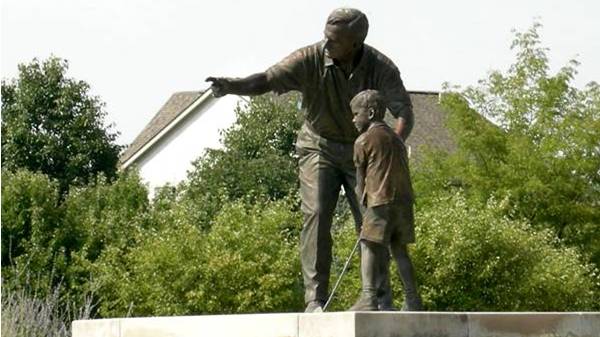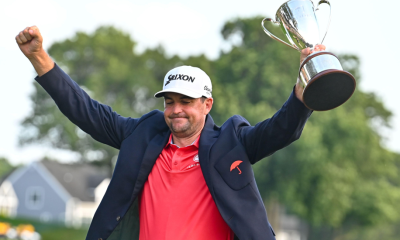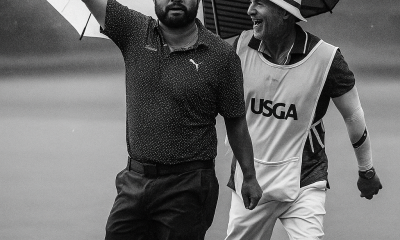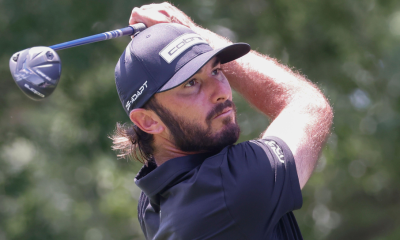Opinion & Analysis
Pappas: Ready for memorable moments at the Memorial?

By Pete Pappas
GolfWRX Staff Writer
The Memorial Tournament at Muirfield Village is one of my favorite events of the season. And not just because it’s a stone’s throw down the road from me in Dublin, Ohio, one of just two times the Tour visits the “Buckeye State.”
It’s also because Muirfield is “Jack’s Place.”
You know you’re in for something special at Muirfield immediately when you’re greeted by a larger than life bronze sculpture of the 19-time major winner Jack Nicklaus instructing a young boy on the golf swing.
The child seems to hang on Jack’s every word but also appears mischievously eager to put the ball in play.
Jack points out towards the horizon as if to instruct his mindful pupil “now before you hit the ball you need to pick a spot out there and an intermediate target too …” (referring to his meticulously famous pre-shot routine in picking primary and intermediate targets to establish aim).
When the “Golden Bear” created the Memorial in 1976 he envisioned an event that would draw the world’s top players to central Ohio. And it has not disappointed.
World No. 1 Luke Donald, World No. 2 Rory McIlroy, World No. 7 Tiger Woods (making his 13th appearance but absent since 2010), and defending champion World No. 8 Steve Stricker will all tee it up Thursday in Dublin for the 37th playing of the Memorial.
Last year Stricker shot a final round 68 but needed a couple of clutch par-saving putts at No. 16 and No. 17 to pull out a one-shot victory and hold off runner-ups Matt Kuchar and Brandt Jobe (both of whom carded final round 65s).
The field this week includes 18 of the 21 winners on Tour in 2012, 17 of the Top-20 in the FedExCup standings, and eight of the Top-10 in the Official World Golf Rankings.
“It’s on everybody’s short list of tournaments they would love to win,” said World No. 10 Justin Rose. “And that comes down to Jack Nicklaus and what he represents.”
The Memorial is one of just five tournaments given invitational status by the PGA Tour and consequently only 120 players rather than the normal 156 are in the field. The top-75 players on the previous year’s money list are guaranteed invitees.
Also making the event unique is a yearly induction ceremony and plaque presentation honoring golfers who’ve made significant contributions to the game. The special plaques are displayed prominently near the clubhouse. And this year’s inductee is eight-time major champion Tom Watson (who also won the Memorial in 1979 and 1996).
Memorable Memorial Moments
In 1976 Roger Maltbie won the inaugural Memorial Tournament defeating Hale Irwin in a sudden-death playoff, but not without a little luck. On the third playoff hole Maltbie’s approach sailed left of the green, heading straight for the gallery. But his shot miraculously hit a stake and bounced back onto the green. Maltbie salvaged par and went on to win on the next playoff hole.
In 1977 Nicklaus defeated Hubert Green by two strokes after inclement weather forced the tournament to finish on Monday.
In 1984 Nicklaus became a two-time winner of his own tournament defeating Andy Bean in a sudden-death playoff. The win turned out to be Jack’s last non-major victory of his illustrious career.
In 1994 Tom Lehman cruised to a five-shot victory over Greg Norman and established the tournament record shooting 278 (20-under).
In 2001 Woods won the Memorial for the third consecutive year dismantling Sergio Garcia and Paul Azinger by a sizable seven-stroke margin.
The House That Jack Built
Muirfield Village Golf Club is ranked as the sixth most popular course on Tour by the players. It’s also ranked as the 19th most difficult on Tour in 2011.
Muirfield features some of the fastest greens on Tour, and the spectacular par-4 448-yard finishing hole is the toughest on the course.
More than 20,000 spectators gather at No. 18 to witness the tournament’s end and the traditional Nicklaus handshake greeting to the winner walking off the green.
The Greek Syndicate
The beautiful thing about this season is anyone can win any given week. It’s also the horrendous thing about this season as it makes picking a winner all the more difficult.
Nevetheless, I remain undaunted.
With one week off I’m returning fresh and giddy with anticipation this weeks picks will pan out for me.
Here we go.
Top-25
Phil Mickelson (16/1)
Mickelson bounced back at the HP Byron Nelson Championship two weeks ago finishing in seventh place with a strong final round. But he’s struggled overall this past month, particularly with inconsistent iron play.
I don’t think he finds consistency this week. He’ll have a good opening few days, but fall off over the weekend.
Stricker (25/1)
Stricker’s silky smooth putting stroke helped him win here last year. But he’s never played well at Muirfield before last season.
His victory here last year was driven in large part by a wildly hot streak in the middle rounds that I just don’t see him duplicating.
Top-10
Donald (9/1)
Donald has finished in the top-6 in five of his last seven starts. And the new World No. 1 has 15 top-10 finishes in his last 17 events. Sizzle!
Donald is on a roll and I always bet on the hot hand.
Top-5
Justin Rose (18/1)
I love what Rose has done this year. Four top-10 finishes and a victory. He won here in 2010 by three shots over Rickie Fowler.
For my money he’s come closer than any player to having three wins this season. I like him and Fowler to battle it out on Sunday down the stretch.
Outside Top-25
Mcilroy (12/1)
McIlroy has two top-10 finishes at Muirfield the past two years. But he’s struggled of late.
Even with all his talent I don’t see him turning it around this week. However another poor finish might be the wake-up call he needs with the U.S. Open approaching.
Woods (16/1)
Woods has never missed a cut at Muirfield. He has 10 top-10 finishes here. And he has the best scoring average at Memorial of anyone in the field.
So why pick him to finish outside the top-25?
Because I believe Woods is an absolute wreck. And he won’t be fixed until he reunites with Butch Harmon.
You heard it here first. Expect a Woods-Harmon reunion next season (I’m invoking my privilege to not reveal my confidential source).
And expect continued inconsistent and mediocre play from Woods the rest of this season (no source on this one, just common sense).
Missed Cut
Bubba Watson (22/1)
Watson’s admittedly rusty. But he expects to “play good golf.” I think the spotlight and attention is still a learning experience for him and growing pains are forthcoming.
Watson’s great for the game. But he won’t be around this weekend.
Winner
Rickie Fowler (20/1)
People have been waiting for Rickie to break out for some time now and now that he finally has he’s a different player.
Fowler was a runner-up here in 2010.
He’s always had the talent. It was just a matter of when. Fowler picks up another win and puts himself into contention for “2012 Player of the Year.”
Groups To Watch
Kyle Stanley, Mark Wilson, Jason Day
Luke Donald, Rory McIlroy, Keegan Bradley
Tiger Woods, Bill Haas, Fred Couples
Hunter Mahan, Justin Rose, Steve Sticker
Rickie Fowler, Bubba Watson, Phil Mickelson
Tiger Woods, Bill Haas, Freddie Couples
Ryan Moore, Spencer Levin, Greg Owen
Brandt Snedeker, Dustin Johnson, Adam Scott
Charley Hoffman, Ernie Els, Stewart Cink.
The Yellow Shirt
Before Fowler decided “Sing Sing Prison Orange” was a good look for Championship Sunday, and before Tiger’s “Fire Red” became a reason for competitors to cringe in fear at Woods’ mere presence…
There was Jack’s “Yellow Shirt.”
Jack’s yellow shirt of course commemorates that remarkable day in 1986 when the 46 year-old “Golden Bear” in the twilight of his career won The Masters for his sixth and final time. And in the process gave the game one of its greatest moments in history.
What Jack’s yellow shirt also symbolizes however is the even greater gift it gave to a young boy in 1968 who was diagnosed with a rare and terminal cancer at the age of 11.
That boy’s name was Craig Smith.
Craig loved golf. Jack was his idol. And yellow was Craig’s favorite color.
After Jack learned of Craig’s diagnosis he met with Craig and promised him he’d wear yellow every Sunday as his way of saying “Hello Craig.”
“I wanted to bring as much joy into the last part of that boy’s life as I could,” Jack said. “It was a mutual thing between us.”
It was mutual because Craig also wore yellow on Sundays.
Craig’s mother recalled watching Craig leaping off the sofa with excitement the first time he saw Jack wearing yellow on television, “Craig would say ‘hello to you too Jack’ when he watched Jack,” his mom said.
It was their secret, between Jack and Craig.
Tragically two years later Craig lost his courageous battle with cancer and passed away at age 13.
In 1986 Nicklaus’ game was in decline and his career on its last legs. He hadn’t won a tournament in two years. And it had been six years since he last won a major.
But something unbelievable would happen at the 1986 Masters. And many believe it was because Nicklaus decided to wear the yellow shirt on Sunday one more time.
Yellow is the color of rebirth. And Jack wore it again to inspire and honor the memory of his brave young friend with an unwavering spirit.
As Jack walked up the 18th fairway on Sunday about to win The Masters for the sixth time, he couldn’t help but believe Craig was watching from above.
“I looked up to sky and said wow, is this really happening?” Jack said.
Today the Yellow Shirt Fund exists to support pediatric cancer patients nationwide including those in Ohio being treated at Nationwide Children’s Hospital.
And Jack’s “yellow shirt” more than ever still inspires us all to continue in the fight against pediatric cancer.
Notes
Tickets for the event are always some of the biggest sellers for any non-major on the PGA Tour.
Purse: $6.2 million; Winner’s share: $1.116 million
Television Coverage
Thursday and Friday: Golf Channel 3:00 – 6:00 p.m. EST
Saturday and Sunday: NBC 3:00 – 6:00 p.m. EST
Radio Coverage
Thursday through Sunday: SiriusXM Satellite Radio 12:00 – 6:00 pm ET
Odds
Odds provided by Las Vegas PGA Tour Golf Betting Odds.
You can follow Pete on Twitter @TheGreekGrind
Opinion & Analysis
The 2 primary challenges golf equipment companies face

As the editor-in-chief of this website and an observer of the GolfWRX forums and other online golf equipment discourse for over a decade, I’m pretty well attuned to the grunts and grumbles of a significant portion of the golf equipment purchasing spectrum. And before you accuse me of lording above all in some digital ivory tower, I’d like to offer that I worked at golf courses (public and private) for years prior to picking up my pen, so I’m well-versed in the non-degenerate golf equipment consumers out there. I touched (green)grass (retail)!
Complaints about the ills of and related to the OEMs usually follow some version of: Product cycles are too short for real innovation, tour equipment isn’t the same as retail (which is largely not true, by the way), too much is invested in marketing and not enough in R&D, top staffer X hasn’t even put the new driver in play, so it’s obviously not superior to the previous generation, prices are too high, and on and on.
Without digging into the merits of any of these claims, which I believe are mostly red herrings, I’d like to bring into view of our rangefinder what I believe to be the two primary difficulties golf equipment companies face.
One: As Terry Koehler, back when he was the CEO of Ben Hogan, told me at the time of the Ft Worth irons launch, if you can’t regularly hit the golf ball in a coin-sized area in the middle of the face, there’s not a ton that iron technology can do for you. Now, this is less true now with respect to irons than when he said it, and is less and less true by degrees as the clubs get larger (utilities, fairways, hybrids, drivers), but there remains a great deal of golf equipment truth in that statement. Think about it — which is to say, in TL;DR fashion, get lessons from a qualified instructor who will teach you about the fundamentals of repeatable impact and how the golf swing works, not just offer band-aid fixes. If you can’t repeatably deliver the golf club to the golf ball in something resembling the manner it was designed for, how can you expect to be getting the most out of the club — put another way, the maximum value from your investment?
Similarly, game improvement equipment can only improve your game if you game it. In other words, get fit for the clubs you ought to be playing rather than filling the bag with the ones you wish you could hit or used to be able to hit. Of course, don’t do this if you don’t care about performance and just want to hit a forged blade while playing off an 18 handicap. That’s absolutely fine. There were plenty of members in clubs back in the day playing Hogan Apex or Mizuno MP-32 irons who had no business doing so from a ballstriking standpoint, but they enjoyed their look, feel, and complementary qualities to their Gatsby hats and cashmere sweaters. Do what brings you a measure of joy in this maddening game.
Now, the second issue. This is not a plea for non-conforming equipment; rather, it is a statement of fact. USGA/R&A limits on every facet of golf equipment are detrimental to golf equipment manufacturers. Sure, you know this, but do you think about it as it applies to almost every element of equipment? A 500cc driver would be inherently more forgiving than a 460cc, as one with a COR measurement in excess of 0.83. 50-inch shafts. Box grooves. And on and on.
Would fewer regulations be objectively bad for the game? Would this erode its soul? Fortunately, that’s beside the point of this exercise, which is merely to point out the facts. The fact, in this case, is that equipment restrictions and regulations are the slaughterbench of an abundance of innovation in the golf equipment space. Is this for the best? Well, now I’ve asked the question twice and might as well give a partial response, I guess my answer to that would be, “It depends on what type of golf you’re playing and who you’re playing it with.”
For my part, I don’t mind embarrassing myself with vintage blades and persimmons chasing after the quasi-spiritual elevation of a well-struck shot, but that’s just me. Plenty of folks don’t give a damn if their grooves are conforming. Plenty of folks think the folks in Liberty Corner ought to add a prison to the museum for such offences. And those are just a few of the considerations for the amateur game — which doesn’t get inside the gallery ropes of the pro game…
Different strokes in the game of golf, in my humble opinion.
Anyway, I believe equipment company engineers are genuinely trying to build better equipment year over year. The marketing departments are trying to find ways to make this equipment appeal to the broadest segment of the golf market possible. All of this against (1) the backdrop of — at least for now — firm product cycles. And golfers who, with their ~15 average handicap (men), for the most part, are not striping the golf ball like Tiger in his prime and seem to have less and less time year over year to practice and improve. (2) Regulations that massively restrict what they’re able to do…
That’s the landscape as I see it and the real headwinds for golf equipment companies. No doubt, there’s more I haven’t considered, but I think the previous is a better — and better faith — point of departure when formulating any serious commentary on the golf equipment world than some of the more cynical and conspiratorial takes I hear.
Agree? Disagree? Think I’m worthy of an Adam Hadwin-esque security guard tackle? Let me know in the comments.
@golfoncbs The infamous Adam Hadwin tackle ? #golf #fyp #canada #pgatour #adamhadwin ? Ghibli-style nostalgic waltz – MaSssuguMusic
Podcasts
Fore Love of Golf: Introducing a new club concept

Episode #16 brings us Cliff McKinney. Cliff is the founder of Old Charlie Golf Club, a new club, and concept, to be built in the Florida panhandle. The model is quite interesting and aims to make great, private golf more affordable. We hope you enjoy the show!
Opinion & Analysis
On Scottie Scheffler wondering ‘What’s the point of winning?’

Last week, I came across a reel from BBC Sport on Instagram featuring Scottie Scheffler speaking to the media ahead of The Open at Royal Portrush. In it, he shared that he often wonders what the point is of wanting to win tournaments so badly — especially when he knows, deep down, that it doesn’t lead to a truly fulfilling life.
View this post on Instagram
“Is it great to be able to win tournaments and to accomplish the things I have in the game of golf? Yeah, it brings tears to my eyes just to think about it because I’ve literally worked my entire life to be good at this sport,” Scheffler said. “To have that kind of sense of accomplishment, I think, is a pretty cool feeling. To get to live out your dreams is very special, but at the end of the day, I’m not out here to inspire the next generation of golfers. I’m not out here to inspire someone to be the best player in the world, because what’s the point?”
Ironically — or perhaps perfectly — he went on to win the claret jug.
That question — what’s the point of winning? — cuts straight to the heart of the human journey.
As someone who’s spent over two decades in the trenches of professional golf, and in deep study of the mental, emotional, and spiritual dimensions of the game, I see Scottie’s inner conflict as a sign of soul evolution in motion.
I came to golf late. I wasn’t a junior standout or college All-American. At 27, I left a steady corporate job to see if I could be on the PGA Tour starting as a 14-handicap, average-length hitter. Over the years, my journey has been defined less by trophies and more by the relentless effort to navigate the deeply inequitable and gated system of professional golf — an effort that ultimately turned inward and helped me evolve as both a golfer and a person.
One perspective that helped me make sense of this inner dissonance around competition and our culture’s tendency to overvalue winning is the idea of soul evolution.
The University of Virginia’s Division of Perceptual Studies has done extensive research on reincarnation, and Netflix’s Surviving Death (Episode 6) explores the topic, too. Whether you take it literally or metaphorically, the idea that we’re on a long arc of growth — from beginner to sage elder — offers a profound perspective.
If you accept the premise literally, then terms like “young soul” and “old soul” start to hold meaning. However, even if we set the word “soul” aside, it’s easy to see that different levels of life experience produce different worldviews.
Newer souls — or people in earlier stages of their development — may be curious and kind but still lack discernment or depth. There is a naivety, and they don’t yet question as deeply, tending to see things in black and white, partly because certainty feels safer than confronting the unknown.
As we gain more experience, we begin to experiment. We test limits. We chase extreme external goals — sometimes at the expense of health, relationships, or inner peace — still operating from hunger, ambition, and the fragility of the ego.
It’s a necessary stage, but often a turbulent and unfulfilling one.
David Duval fell off the map after reaching World No. 1. Bubba Watson had his own “Is this it?” moment with his caddie, Ted Scott, after winning the Masters.
In Aaron Rodgers: Enigma, reflecting on his 2011 Super Bowl win, Rodgers said:
“Now I’ve accomplished the only thing that I really, really wanted to do in my life. Now what? I was like, ‘Did I aim at the wrong thing? Did I spend too much time thinking about stuff that ultimately doesn’t give you true happiness?’”
Jim Carrey once said, “I think everybody should get rich and famous and do everything they ever dreamed of so they can see that it’s not the answer.”
Eventually, though, something shifts.
We begin to see in shades of gray. Winning, dominating, accumulating—these pursuits lose their shine. The rewards feel more fleeting. Living in a constant state of fight-or-flight makes us feel alive, yes, but not happy and joyful.
Compassion begins to replace ambition. Love, presence, and gratitude become more fulfilling than status, profits, or trophies. We crave balance over burnout. Collaboration over competition. Meaning over metrics.
Interestingly, if we zoom out, we can apply this same model to nations and cultures. Countries, like people, have a collective “soul stage” made up of the individuals within them.
Take the United States, for example. I’d place it as a mid-level soul: highly competitive and deeply driven, but still learning emotional maturity. Still uncomfortable with nuance. Still believing that more is always better. Despite its global wins, the U.S. currently ranks just 23rd in happiness (as of 2025). You might liken it to a gifted teenager—bold, eager, and ambitious, but angsty and still figuring out how to live well and in balance. As much as a parent wants to protect their child, sometimes the child has to make their own mistakes to truly grow.
So when Scottie Scheffler wonders what the point of winning is, I don’t see someone losing strength.
I see someone evolving.
He’s beginning to look beyond the leaderboard. Beyond metrics of success that carry a lower vibration. And yet, in a poetic twist, Scheffler did go on to win The Open. But that only reinforces the point: even at the pinnacle, the question remains. And if more of us in the golf and sports world — and in U.S. culture at large — started asking similar questions, we might discover that the more meaningful trophy isn’t about accumulating or beating others at all costs.
It’s about awakening and evolving to something more than winning could ever promise.






















cjoel
Jun 4, 2012 at 2:34 pm
Woods is an absolute wreck?? Ha. Feeling a little foolish over those comments yet?